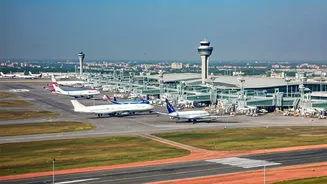Initial Disruptions Unveiled
The initial issue at Delhi's Indira Gandhi International Airport began with extensive delays and operational challenges that soon caused problems for hundreds
of passengers. Multiple factors were at play, contributing to the difficulties. Congestion emerged as a primary concern, as increased passenger traffic strained the existing infrastructure. Staffing shortages added to the operational woes. Security checkpoints and boarding gates struggled to cope with the influx of travelers, resulting in delays. Furthermore, technical glitches complicated the situation. These factors combined created a chaotic environment and caused a ripple effect across the airport operations. A total of 800 flights were affected due to the disruption.
Factors Behind Chaos
Several issues conspired to create the challenging conditions seen at Delhi Airport. One major cause was congestion. The airport, already handling high passenger volumes, struggled to manage peak times efficiently. Reduced staff due to illness or other issues also contributed to the problem, leading to longer wait times at critical points. Simultaneously, unforeseen technical issues also cropped up. These problems ranged from malfunctioning equipment to issues with the airport's IT infrastructure. The convergence of these various factors intensified the challenges, resulting in extended delays, disrupted schedules, and frustrated passengers. A combination of increased traffic, staffing limitations, and technical faults made airport operations difficult.
Impact on Passengers
The widespread disruptions at the Delhi Airport significantly impacted passengers, causing inconvenience and stress. Delays forced travelers to adjust schedules, missing connecting flights, or altering travel plans. Stranded passengers were often stuck at the airport for extended periods, dealing with limited information, and facing frustration. Communication breakdowns and logistical difficulties amplified the problems, making it difficult for passengers to navigate their travel problems. The chaos caused stress and anxiety as people tried to adapt to the disruptions. Passengers felt the negative effects of the delays caused by congestion, limited staff, and technical issues. Many travelers were left with negative experiences.
Looking Ahead and Solutions
Addressing the challenges at Delhi Airport requires a multifaceted approach to improve airport operations and avoid future disruptions. Enhancements to the existing infrastructure, such as expanding terminal capacity and optimizing passenger flow, are crucial. Additionally, an increase in staffing levels, with trained personnel, can help alleviate bottlenecks. Improving the resilience of the airport's technology infrastructure, along with better communication systems, is also essential. By prioritizing these areas, airport authorities can enhance overall efficiency and improve the passenger experience. These actions are designed to minimize similar events.














